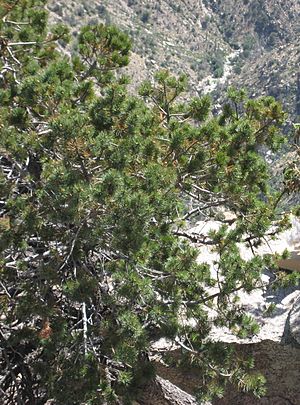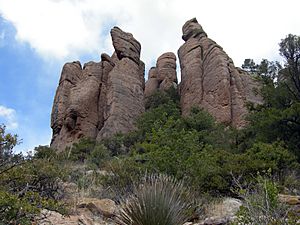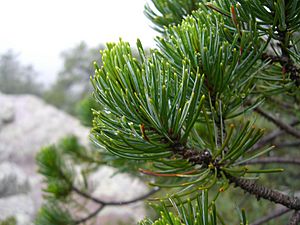Johann's pine facts for kids
Quick facts for kids Johann's pine |
|
|---|---|
 |
|
| Scientific classification | |
| Genus: |
Pinus
|
| Species: |
johannis
|

The Johann's pine, or Pinus johannis, is a unique type of pine tree. It is part of the pinyon pine family. You can find it growing naturally in North America. Its home ranges from southeastern Arizona and southwestern New Mexico in the United States. It also grows south into Mexico, along the Sierra Madre Occidental and Sierra Madre Oriental mountain ranges. You can spot it as far south as Zacatecas and San Luis Potosí. This pine tree prefers to live in cool, dry places. It grows at medium to high elevations, usually between 1,600 and 3,000 meters (about 5,250 to 9,840 feet) above sea level.
Contents
What Does Johann's Pine Look Like?
The Johann's pine is a small to medium-sized tree. Sometimes, it even grows more like a shrub. It can reach a height of 4 to 10 meters (about 13 to 33 feet). Its trunk can grow up to 50 centimeters (about 20 inches) wide.
Bark and Needles
The bark of this pine tree is grey-brown. It is thin and looks a bit scaly, especially near the bottom of the trunk. The leaves of the Johann's pine are called 'needles'. They grow in small groups, usually with three or four needles together. These needles are thin and measure about 3 to 6 centimeters (1.2 to 2.4 inches) long. They are a deep green or blue-green color. If you look closely, you'll see a bright white stripe on the inside of each needle. This stripe is where the tree breathes through tiny openings called stomata.
Cones and Seeds
The cones of the Johann's pine are round. When they are closed, they are about 2 to 4 centimeters (0.8 to 1.6 inches) long and 2 to 3 centimeters (0.8 to 1.2 inches) wide. At first, the cones are green. After about 16 to 18 months, they turn yellow-brown when they are ready. These cones have only a few thin, delicate scales. Usually, there are 6 to 12 scales that hold seeds.
When the cones open, they become wider, about 3 to 5 centimeters (1.2 to 2 inches) across. The seeds stay on the scales even after the cone opens. The seeds themselves are quite large, about 9 to 12 millimeters (0.35 to 0.47 inches) long. They have a thick shell and a white inside part called an endosperm. They also have a tiny wing, only 1 to 2 millimeters long.
How Seeds Travel
The seeds of the Johann's pine are spread by a bird called the Mexican jay. This bird loves to eat the seeds. It pulls the seeds out of the open cones. The Mexican jay uses these seeds as a big part of its diet. It also stores many seeds for later use. Some of these stored seeds are never eaten. These forgotten seeds can then grow into new pine trees! This is a great way for the pine tree to spread its seeds.
History of Discovery
The Johann's pine was only recently identified as its own species. In 1968, a scientist named Elbert L. Little noticed differences in pinyon pines growing in Arizona. He compared them to the typical Mexican pinyon (Pinus cembroides) found in Mexico. He first thought it was just a different type, or variety, of Mexican pinyon. He called it Pinus cembroides var. bicolor. He saw that its needles had stomata in a very different place. Also, it had 3–4 needles per group, not 2–3 like the Mexican pinyon. Its cones had thinner scales, and the tree had a denser, rounder shape.
Later, more scientists, like Marie-Françoise Robert-Passini, Dana K. Bailey, and Frank G. Hawksworth, studied it further. They found that it was different enough to be its own species. Even though it often grows near the Mexican pinyon, it doesn't mix with it. This is because the Johann's pine pollinates later in the summer, about one to two months after the Mexican pinyon. This difference in timing stops them from hybridizing.
Because different scientists were working in different areas at the same time, the tree was named twice. Marie-Françoise Robert-Passini named it Pinus johannis (after her husband Jean) while studying trees in eastern Mexico. Later, Bailey and Hawksworth named it Pinus discolor while studying trees in Arizona. Scientists generally agree that Pinus johannis is the correct name for this unique species.
The Johann's pine is closely related to the Orizaba pinyon (Pinus orizabensis) and the Potosi pinyon (Pinus culminicola). It shares a similar leaf structure with these trees.
Uses of Johann's Pine
The seeds of the Johann's pine are pine nuts. They are edible and collected in Mexico, though not in large amounts.
This tree is also very attractive. The white inner surfaces of its needles make it stand out. Because it's a small tree, it's a good choice for parks and large gardens. It can also handle dry weather well.
See also
 In Spanish: Pinus johannis para niños
In Spanish: Pinus johannis para niños


